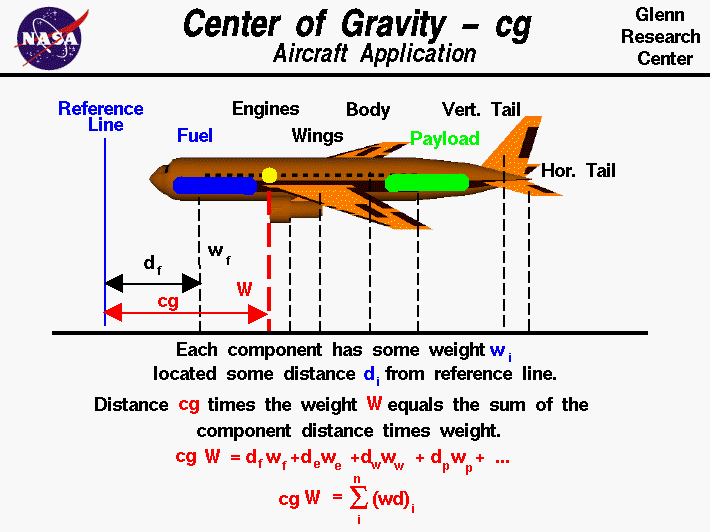How To Find The Cg Of An Aircraft

An plane in flight can be maneuvered by the pilot using the aerodynamic command surfaces; the lift, rudder, or ailerons. As the control surfaces change the amount of force that each surface generates, the aircraft rotates about a point called the middle of gravity. The center of gravity is the boilerplate location of the weight of the aircraft. The weight is actually distributed throughout the aeroplane, and for some problems it is important to know the distribution. But for full aircraft maneuvering, we need to exist concerned with only the total weight and the location of the eye of gravity.
How do engineers determine the location of the center of gravity for an airplane which they are designing?
An aeroplane is a combination of many parts; the wings, engines, fuselage, and tail, plus the payload and the fuel. Each office has a weight associated with information technology which the engineer tin estimate, or calculate, using Newton's weight equation:
w = one thousand * g
where w is the weight, m is the mass, and g is the gravitational constant which is 32.2 ft/square sec in English units and 9.8 meters/square sec in metric units. To determine the middle of gravity cg, nosotros choose a reference location, or reference line. The cg is adamant relative to this reference location. The total weight of the aircraft is simply the sum of all the individual weights of the components. Since the center of gravity is an average location of the weight, we can say that the weight of the entire aircraft Westward times the location cg of the center of gravity is equal to the sum of the weight w of each component times the distance d of that component from the reference location:
W * cg = [westward * d](fuselage) + [due west * d](wing) + [due west * d](engines) + ...
The heart of gravity is the mass-weighted boilerplate of the component locations.
We tin can generalize the technique discussed above. If we had a full of "n" discrete components, the eye of gravity cg of the shipping times the weight W of the aircraft would be the sum of the private i component weight times the distance d from the reference line (west * d) with the index i going from 1 to n. Mathematicians use the greek letter sigma to denote this addition. (Sigma is a zig-zag symbol with the index designation being placed below the lesser bar, the total number of additions placed over the top bar, and the variable to be summed placed to the correct of the sigma with each component designated past the index.)
W * cg = SUM(i=1 to i=n) [w * d]i
This equation says that the center of gravity times the sum of "north" parts' weight is equal to the sum of "n" parts' weight times their distance. The discrete equation works for "n" discrete parts.
Activities:
Guided Tours
Navigation ..
- Beginner's Guide Dwelling house Page
How To Find The Cg Of An Aircraft,
Source: https://www.grc.nasa.gov/www/k-12/airplane/acg.html
Posted by: truemansweeng.blogspot.com


0 Response to "How To Find The Cg Of An Aircraft"
Post a Comment